Many guitarists, from beginners to seasoned players, ponder the seemingly simple yet crucial aspect of guitar playing: how to hold a pick correctly. While it might appear trivial, mastering the guitar pick grip can significantly impact your tone, control, and overall playing experience. This guide delves into the nuances of holding a guitar pick, exploring various techniques and offering insights to help you discover the best approach for your playing style.
There isn’t one single “correct” way to hold a guitar pick, as personal preference and playing style play significant roles. However, understanding the fundamental methods and their implications can empower you to make informed decisions and refine your technique for optimal results. Let’s explore three primary methods of holding a guitar pick, often referred to as the “O” method, the “pinch” method, and the “fist” method.
The “O” Method: Balancing Control and Tone
The “O” method is arguably the most common and versatile approach, often recommended for beginners and favored by players across various genres. This technique involves forming an elongated “O” shape with your thumb and index finger. The pick is held between the side of your thumb and the side of your index finger’s tip.
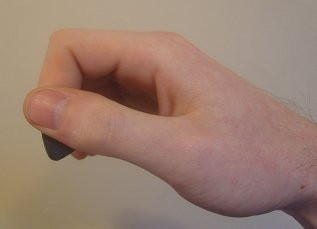 O Method Guitar Pick Hold 1
O Method Guitar Pick Hold 1
 O Method Guitar Pick Hold 2
O Method Guitar Pick Hold 2
Advantages of the “O” Method:
- Versatility: This method provides a good balance between control and flexibility, making it suitable for both rhythm and lead playing across different musical styles.
- Control: The “O” grip offers a solid hold on the pick, allowing for precise and controlled picking, essential for accurate note articulation and intricate passages.
- Tone: It facilitates a balanced tone, neither too harsh nor too soft, making it adaptable to various musical contexts and pick gauges.
The “Pinch” Method: Enhanced Flexibility for Strumming
The “pinch” method offers a more flexible approach to holding the guitar pick, prioritizing strumming fluidity and a lighter touch. In this technique, you use the flat of your index finger rather than the side to pinch the pick against your thumb.
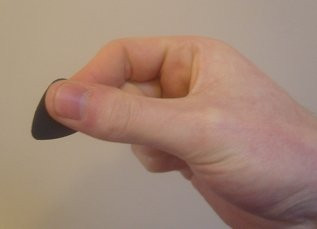 Pinch Method Guitar Pick Hold 1
Pinch Method Guitar Pick Hold 1
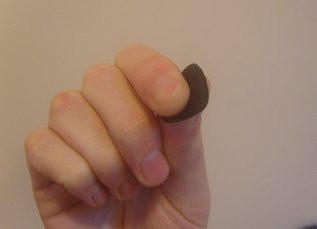 Pinch Method Guitar Pick Hold 2
Pinch Method Guitar Pick Hold 2
Advantages of the “Pinch” Method:
- Flexibility: The “pinch” grip allows for greater pick flexibility, which is particularly beneficial for strumming and creating a softer, more nuanced tone.
- Strumming: This method is well-suited for strumming patterns, especially with lighter gauge picks, enabling smooth and flowing rhythm guitar parts.
- Light Touch: It encourages a lighter touch, which can be advantageous for delicate playing and avoiding an overly aggressive or harsh tone.
Considerations for the “Pinch” Method:
- Control: Compared to the “O” method, the “pinch” grip may offer slightly less control, especially for fast, articulate lead playing.
- Pick Gauge: This method often pairs well with softer or lighter gauge picks to maximize flexibility and strumming ease.
The “Fist” Method: Power and Attack for Heavier Styles
The “fist” method, sometimes favored by bluegrass and heavier style players, emphasizes power and a strong attack. This technique involves curling your index finger more significantly, positioning the top part of your index finger roughly parallel to your thumb, creating a more closed “fist-like” grip.
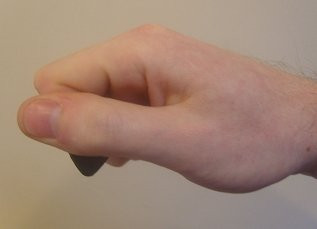 Fist Method Guitar Pick Hold 1
Fist Method Guitar Pick Hold 1
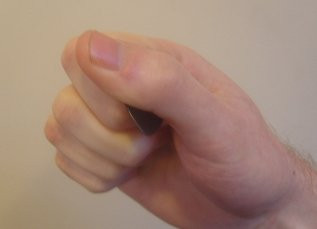 Fist Method Guitar Pick Hold 2
Fist Method Guitar Pick Hold 2
Advantages of the “Fist” Method:
- Power: The “fist” grip can generate a more powerful and louder tone, particularly beneficial for genres like bluegrass and heavier rock or metal.
- Attack: It facilitates a strong pick attack, allowing for aggressive and dynamic playing styles.
- Heavier Gauges: This method often complements heavier gauge picks, providing the necessary control and stability for thicker picks.
Considerations for the “Fist” Method:
- Control: While powerful, the “fist” grip may require more practice to achieve the same level of finesse and control as the “O” method, especially for delicate or intricate passages.
- Smooth Rhythm: Maintaining smooth rhythm playing might initially be more challenging with this method, requiring focused practice on pick depth and consistency.
Experimentation and Finding Your Grip
Ultimately, the best way to hold a guitar pick is the one that feels most natural and comfortable for you while producing the desired tone and control for your playing style. Experimentation is key. Try each of these methods, along with slight variations, to discover what resonates best with your hands and musical preferences.
Consider these factors as you experiment:
- Pick Gauge: Different pick gauges can feel and sound different with each holding method. Experiment with various thicknesses to find combinations that work for you.
- Musical Style: Your preferred musical genres may influence your ideal pick grip. Strumming-heavy styles might favor the “pinch” method, while genres demanding power and attack might lean towards the “fist” method. The “O” method remains a versatile choice for almost any genre.
- Comfort and Fatigue: Pay attention to hand comfort and fatigue. A proper grip should feel secure yet relaxed, allowing for extended playing sessions without strain.
Adapting Your Grip to Music Style
As you progress, you might find yourself subtly adjusting your pick grip depending on the musical context. For instance, you might loosen your grip slightly for strumming delicate passages or tighten it for fast, articulate lead lines. This adaptability is a hallmark of experienced players who intuitively adjust their technique to serve the music.
Stick With What Works (Mostly)
While experimentation is encouraged, especially in your early stages of playing, avoid constantly switching your grip once you’ve found a method that works reasonably well. Consistent practice with a chosen grip will develop muscle memory and refine your technique over time. Frequent changes can hinder this crucial internalization process.
If you’ve been playing with a particular grip for years and have made significant progress, switching to a completely new method might require a step backward initially. Unless you are experiencing significant limitations or discomfort, minor adjustments to your existing grip are often more beneficial than a complete overhaul.
Final Thoughts: Personal Preference and Musical Goals
There is no universally “correct” way to hold a guitar pick. The optimal grip is a personal choice influenced by your hand anatomy, playing style, musical preferences, and desired tone. By understanding the fundamental methods, experimenting thoughtfully, and focusing on consistent practice, you can develop a pick grip that empowers you to express yourself musically with confidence and control.
